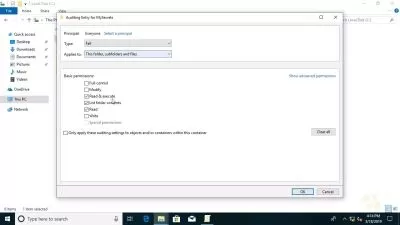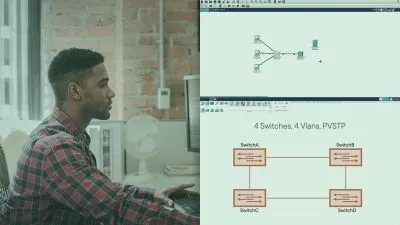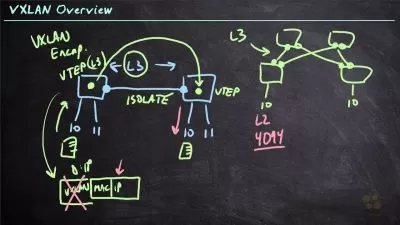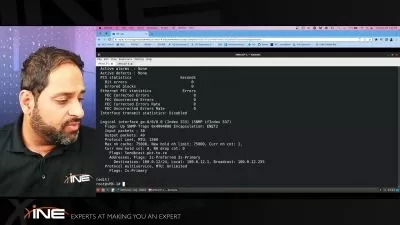5G NR (New Radio) Technical Training-A Deep Dive
Dr. Moazzam Tiwana
5:33:19
Description
5G RAT, 5G NSA & SA Deployment, Massive MIMO & Beam Forming, 5G NR Protocol Stack, RAN Split Options, , 5G Air Interface
What You'll Learn?
- Introduction to 5G NR (New Radio)
- 5G Radio Access Technology (RAT)
- Massive MIMO And Beam Forming in 5G
- 5G NR Protocol Stack
- 5G RAN/gNB split Options
- 5G NR Radio Access Network (RAN) Deployment Options
- 5G NR Air Interface
Who is this for?
What You Need to Know?
More details
Description5G NR (New Radio) is a new Radio Access Technology (RAT) developed by 3GPP for the 5G mobile networks. In this course you will have an in-depth understanding about 5G Radio Access Network (RAN) based upon the 3rd Generation Partnership Project (3GPP) standard and specifications.
The 5G New Radio standards developed by 3GPP is intended to significantly improve the performance, flexibility, scalability and efficiency of mobile networks. In this way 5G was designed to be able to ensure the optimum use of the available spectrum, whether it is licensed, shared or unlicensed, and achieve this across a wide variety of spectrum bands. 5G New Radio is able to provide high bandwidth communication for the transmission of streaming services as well as low latency services.
This course is targeted for:
Telecom professionals/ engineers
Telecom students
Networking students
Course Contents:
Section 1: Introduction
          Main Components of a 5G Network Architecture
          Next Generation NodeB (gNB)
          PDU (Protocol Data Unit) Sessions
          5G Use Cases Mapped to Difference Usage Scenarios
          5G NR Frequency Bands
          Most Popular 5G Bands
Section 2: 5G Radio (Wireless) Access Technology (RAT)
          5G Wireless Access Technology
          Basics of Orthogonal Frequency Division Multiplexing (OFDM)
          OFDM in Its Simplest Form
          OFDM IN Practice (Simplified Model)
          Mutipath Environment And Cyclic Prefix
          5G Flexible Numerology and Frame Structure
          5G Resource Block (RB) and Resource Element (RE)
          5G FDD TDD Modes-SUL and SDL Frequency Bands
          Slot Formats and Slot Format Indicators (SFI) in 5G
          5G NR self Contained Slots
          Mini-Slots in 5G NR
          Modulation in 5G
          Adaptive Modulation and Coding in 5G
          Modulation and the Coding Schemes (MCS) in 5G
          Why Lower Numerology-SCS for Larger Cell Size
          SCS Vs Cell Size
          Advantages of TDD Deployment
          5G Frequency Bands in FR1 and FR2
Section 3:Massive MIMO And Beam Forming in 5G
          Introduction to MIMO, Beamforming and Massive MIMO
          5G NR Transmission Chain
          Types of Beamforming-Analog Beamforming
          Digital Beamforming
          Hybrid Beamforming
          5G NR Active Antenna System (AAS)
          8T8R & 64T64R Configurations in 5G Active Antenna System (AAS)
          Comparison of Antenna Sizes in Sub 6 GHz & mmWave
          Virtualized Antenna Representation
          Active Antenna Unit (AAU) in 5G
          Antenna Configurations for Different RF Planning Scenarios
          Single Panel & Multi-panel Antennas
          Grid of Beams (GoB)
          Antenna Port Vs Physical Antenna
          Quasi Co-Located (QCL) Ports
          DL MIMO Characteristics in Sub 6GHZ
          DL MIMO Characteristics in mmWave
          Why DL-MU-MIMO is Limited to Maximum 16 Layers?
          UL-MIMO Characteristics
          Why Channel State Information (CSI) in Important?
          What is Channel State Information (CSI) Report & its Calculation in FDD and TDD?
          Why Use TDD with Large Number of Antenna Ports?
          Types of CSI (Channel State Inormation)
          Types I CSI (Standard Resolution)
           Why Co-phasing is Required?
           Subtypes of Type-I CSI
           Type-II CSI (High Resolution)
           Relationship Between Antenna Subarrays and CSI ports
           Flow Diagrams for Downlink Single User MIMO Procedures
           1. CSI-RS Based DL Single User MMO Procedure
           2. Beamformed CSI-RS Based Procedure for DL SU-MIMO
           3. SRS Based DL Single User MIMO
           UL Transmission Schemes
           1. Codebook Based UL Transmission Scheme
           2. Non-Codebook Based UL Transmission Scheme
Section 4: 5G NR Protocol Stack
          Control and User Plane Separation in 5G
          5G NR Control Plane Protocol Stack
          5G NR User Plane Protocol Stack
          Combined 5G NR Protocol Stack
          5G NAS (Non-Access Stratum) Layer
          Radio Resource Control (RRC) Layer
          Service Data Adaption Protocol (SDAP) Layer
          Packet Data Convergence Protocol (PDCP) Layer
          Radio Link Control (RLC) Layer: Transparent, Acknowledged & Unacknowledged Mode
          Medium Access Layer (MAC) Layer
Section 5: 5G RAN/gNB split Options
                   Horizontal gNB Disaggregation: Central Unit (CU) & Distributed Unit (DU)
          Different RAN Functional Splits
          RAN Split Option 1
          RAN Split Option 2
          RAN Split Option 8
          RAN Split Option 6
          RAN Splits Logical View
          Option 7.2x for 5G Open RAN
          Enhanced CPRI (e-CPRI) Protocol
Section 6: 5G NR Radio Access Network (RAN) Deployment Options
          What is Dual Connectivity (DC)?
          Signaling Radio Bearers in Dual Connectivity (DC)
          Standalone Deployment Options 1 and 2
          5G Non-Standalone (NSA) Option 3, 3a, 3x
          Data Bearer Protocol Stack in Option 3, 3a, 3x
          5G Non-Standalone (NSA) option 4
          5G Non-Standalone (NSA) option 7
          Option 5 and 6: Unlikely Deployment Options
Section 7: 5G NR Air Interface
          Channel Bandwidth & Maximum Transmission BW Configuration
          NR-Absolute Radio Frequency Channel Number (NR-ARFCN)
          Difference Between Global And Channel Raster
          Bandwidth Part in 5G
          Resource Grid on 5G Air Interface
          5G NR Model for Air Interface Channels
            5G NR Logical channels
            5G NR Transport Channels
            5G NR Physical Channels
            1. Demodulation Reference Signal (DM-RS)
              Demodulation Reference Signal (DM-RS) Location in Time Domain
              Demodulation Reference Signal (DM-RS) Location in Frequency Domain
            2. Channel State Information Reference Signal (CSI-RS) Signal:Types and Patterns
            3. Sounding Reference Signal (SRS)
            4. Phase Tracking Reference Signal (PT-RS)Procedures to understand 5G channels
          5G NR Cell Acquisition Procedure
          5G NR Cell Acquisition- Beam Sweeping
          The Number, Location and Pattern of SSBs in a Burst Set for FR1 and FR2
          5G NR Cell Acquisition- Signal Synchronization Block (SSB)
          5G NR Cell Acquisition- Physical Cell ID (PCI)
          5G Cell Acquisition: Minimum system information
          5G Cell Acquisition: Master Information Block (MIB)
          5G Cell Acquisition: Control Resource Set (CORESET)
          5G Cell Acquisition: System Information Block 1 (SIB1)
          Initial Access (RACH Procedure)
          Scheduled Data Transmission Procedure
          Control Resource Set (CORESET) Revisited
          Paging Process
Who this course is for:
- Network and system engineers who want to pursue their carrier in Telecom Industry
- Students and working professionals who want understanding of 5G NR
- Anyone who want to learn protocols and procedures involved in 5G NR
- Anyone who want to upgrade their skills for better job.
5G NR (New Radio) is a new Radio Access Technology (RAT) developed by 3GPP for the 5G mobile networks. In this course you will have an in-depth understanding about 5G Radio Access Network (RAN) based upon the 3rd Generation Partnership Project (3GPP) standard and specifications.
The 5G New Radio standards developed by 3GPP is intended to significantly improve the performance, flexibility, scalability and efficiency of mobile networks. In this way 5G was designed to be able to ensure the optimum use of the available spectrum, whether it is licensed, shared or unlicensed, and achieve this across a wide variety of spectrum bands. 5G New Radio is able to provide high bandwidth communication for the transmission of streaming services as well as low latency services.
This course is targeted for:
Telecom professionals/ engineers
Telecom students
Networking students
Course Contents:
Section 1: Introduction
          Main Components of a 5G Network Architecture
          Next Generation NodeB (gNB)
          PDU (Protocol Data Unit) Sessions
          5G Use Cases Mapped to Difference Usage Scenarios
          5G NR Frequency Bands
          Most Popular 5G Bands
Section 2: 5G Radio (Wireless) Access Technology (RAT)
          5G Wireless Access Technology
          Basics of Orthogonal Frequency Division Multiplexing (OFDM)
          OFDM in Its Simplest Form
          OFDM IN Practice (Simplified Model)
          Mutipath Environment And Cyclic Prefix
          5G Flexible Numerology and Frame Structure
          5G Resource Block (RB) and Resource Element (RE)
          5G FDD TDD Modes-SUL and SDL Frequency Bands
          Slot Formats and Slot Format Indicators (SFI) in 5G
          5G NR self Contained Slots
          Mini-Slots in 5G NR
          Modulation in 5G
          Adaptive Modulation and Coding in 5G
          Modulation and the Coding Schemes (MCS) in 5G
          Why Lower Numerology-SCS for Larger Cell Size
          SCS Vs Cell Size
          Advantages of TDD Deployment
          5G Frequency Bands in FR1 and FR2
Section 3:Massive MIMO And Beam Forming in 5G
          Introduction to MIMO, Beamforming and Massive MIMO
          5G NR Transmission Chain
          Types of Beamforming-Analog Beamforming
          Digital Beamforming
          Hybrid Beamforming
          5G NR Active Antenna System (AAS)
          8T8R & 64T64R Configurations in 5G Active Antenna System (AAS)
          Comparison of Antenna Sizes in Sub 6 GHz & mmWave
          Virtualized Antenna Representation
          Active Antenna Unit (AAU) in 5G
          Antenna Configurations for Different RF Planning Scenarios
          Single Panel & Multi-panel Antennas
          Grid of Beams (GoB)
          Antenna Port Vs Physical Antenna
          Quasi Co-Located (QCL) Ports
          DL MIMO Characteristics in Sub 6GHZ
          DL MIMO Characteristics in mmWave
          Why DL-MU-MIMO is Limited to Maximum 16 Layers?
          UL-MIMO Characteristics
          Why Channel State Information (CSI) in Important?
          What is Channel State Information (CSI) Report & its Calculation in FDD and TDD?
          Why Use TDD with Large Number of Antenna Ports?
          Types of CSI (Channel State Inormation)
          Types I CSI (Standard Resolution)
           Why Co-phasing is Required?
           Subtypes of Type-I CSI
           Type-II CSI (High Resolution)
           Relationship Between Antenna Subarrays and CSI ports
           Flow Diagrams for Downlink Single User MIMO Procedures
           1. CSI-RS Based DL Single User MMO Procedure
           2. Beamformed CSI-RS Based Procedure for DL SU-MIMO
           3. SRS Based DL Single User MIMO
           UL Transmission Schemes
           1. Codebook Based UL Transmission Scheme
           2. Non-Codebook Based UL Transmission Scheme
Section 4: 5G NR Protocol Stack
          Control and User Plane Separation in 5G
          5G NR Control Plane Protocol Stack
          5G NR User Plane Protocol Stack
          Combined 5G NR Protocol Stack
          5G NAS (Non-Access Stratum) Layer
          Radio Resource Control (RRC) Layer
          Service Data Adaption Protocol (SDAP) Layer
          Packet Data Convergence Protocol (PDCP) Layer
          Radio Link Control (RLC) Layer: Transparent, Acknowledged & Unacknowledged Mode
          Medium Access Layer (MAC) Layer
Section 5: 5G RAN/gNB split Options
                   Horizontal gNB Disaggregation: Central Unit (CU) & Distributed Unit (DU)
          Different RAN Functional Splits
          RAN Split Option 1
          RAN Split Option 2
          RAN Split Option 8
          RAN Split Option 6
          RAN Splits Logical View
          Option 7.2x for 5G Open RAN
          Enhanced CPRI (e-CPRI) Protocol
Section 6: 5G NR Radio Access Network (RAN) Deployment Options
          What is Dual Connectivity (DC)?
          Signaling Radio Bearers in Dual Connectivity (DC)
          Standalone Deployment Options 1 and 2
          5G Non-Standalone (NSA) Option 3, 3a, 3x
          Data Bearer Protocol Stack in Option 3, 3a, 3x
          5G Non-Standalone (NSA) option 4
          5G Non-Standalone (NSA) option 7
          Option 5 and 6: Unlikely Deployment Options
Section 7: 5G NR Air Interface
          Channel Bandwidth & Maximum Transmission BW Configuration
          NR-Absolute Radio Frequency Channel Number (NR-ARFCN)
          Difference Between Global And Channel Raster
          Bandwidth Part in 5G
          Resource Grid on 5G Air Interface
          5G NR Model for Air Interface Channels
            5G NR Logical channels
            5G NR Transport Channels
            5G NR Physical Channels
            1. Demodulation Reference Signal (DM-RS)
              Demodulation Reference Signal (DM-RS) Location in Time Domain
              Demodulation Reference Signal (DM-RS) Location in Frequency Domain
            2. Channel State Information Reference Signal (CSI-RS) Signal:Types and Patterns
            3. Sounding Reference Signal (SRS)
            4. Phase Tracking Reference Signal (PT-RS)Procedures to understand 5G channels
          5G NR Cell Acquisition Procedure
          5G NR Cell Acquisition- Beam Sweeping
          The Number, Location and Pattern of SSBs in a Burst Set for FR1 and FR2
          5G NR Cell Acquisition- Signal Synchronization Block (SSB)
          5G NR Cell Acquisition- Physical Cell ID (PCI)
          5G Cell Acquisition: Minimum system information
          5G Cell Acquisition: Master Information Block (MIB)
          5G Cell Acquisition: Control Resource Set (CORESET)
          5G Cell Acquisition: System Information Block 1 (SIB1)
          Initial Access (RACH Procedure)
          Scheduled Data Transmission Procedure
          Control Resource Set (CORESET) Revisited
          Paging Process
Who this course is for:
- Network and system engineers who want to pursue their carrier in Telecom Industry
- Students and working professionals who want understanding of 5G NR
- Anyone who want to learn protocols and procedures involved in 5G NR
- Anyone who want to upgrade their skills for better job.
User Reviews
Rating
Dr. Moazzam Tiwana
Instructor's Courses
Udemy
View courses Udemy- language english
- Training sessions 115
- duration 5:33:19
- Release Date 2022/11/30












